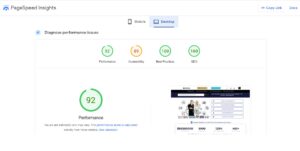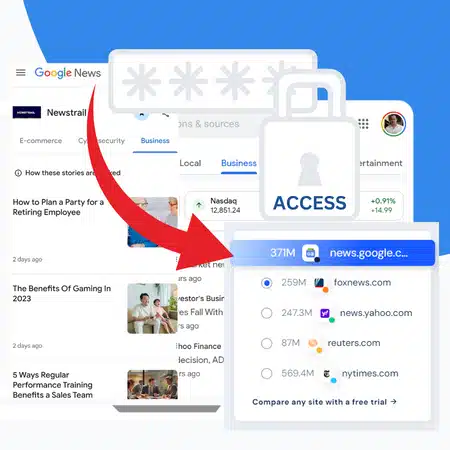What is DA? And what is DR? In the digital marketing and SEO, two metrics often discussed are DA (Domain Authority) and DR (Domain Rank). These indicators, though not officially recognized by Google, hold significant sway in the SEO community. I essentially see these metrics as being exactly the same, although they can sometimes vary by about 5 points as each of the tools used to calculate them, tend to fluctuate. Let’s take a closer look at what they mean for your online presence and why some (including me) say they matter:
Suggested SEO Resources:
Domain Authority (DA): The Moz & SEMRush Metric
Domain Authority, developed by Moz, is a holistic measure of a website’s potential ranking power on search engines. It’s a score between 0 and 100, with higher scores indicating greater likelihood of ranking. DA is logarithmic, meaning it’s progressively harder to increase your score as you move up the scale. This complexity reflects the myriad of factors Moz incorporates, mirroring the multifaceted nature of Google’s algorithm, albeit without direct correlation to Google’s own metrics.
Suggested: Try SEMRush for free and read our SEMRush review.
Domain Rank (DR): The Ahrefs Measure
Parallel to DA, DR (Domain Rank) is a metric from Ahrefs that assesses a website’s backlink profile quality and its potential to rank on search engines. Like DA, DR is scored on a scale from 0 to 100, where a higher DR suggests a stronger, more authoritative backlink profile. Ahrefs emphasizes the importance of quality over quantity when it comes to backlinks, aligning with best practices in SEO.
Understanding the DA and DR Scales
In the quest to optimize blogs and websites for better search engine rankings, grasping the nuances of the DA and DR scales is crucial. These scales not only serve as benchmarks for assessing a site’s authority but also guide strategic decisions in content creation and link-building efforts. Let’s explore each scale in detail.
The DA Scale: Navigating Moz’s Domain Authority
Moz’s Domain Authority scale runs from 0 to 100, offering a snapshot of a site’s potential ranking power. Here’s a breakdown of what different ranges on the DA scale signify:
- 0-10: These sites are usually new with minimal inbound links. This range is the starting point for most websites, where initial SEO efforts can lead to noticeable improvements in DA.
- 11-20: At this stage, sites have begun to establish themselves but remain small, often in niche areas. The focus here is on building a foundation of quality content and securing backlinks.
- 21-30: Sites within this range are starting to see the fruits of their SEO labor, with more consistent growth. It’s a critical phase for differentiating oneself from competitors through enhanced content and strategic marketing.
- 31-40: Reflecting established sites that have gained a foothold in their market. The challenge here is maintaining growth amidst increasing competition.
- 41-50: Represents sites that have invested time and effort into SEO and are beginning to be recognized as authorities in their niche. Link-building and high-quality content are key drivers at this stage.
- 51-60 and 61-70: These ranges indicate sites that have achieved significant authority, often featuring comprehensive content that attracts backlinks naturally. Such sites are well-regarded within their industry.
- 71-80: Sites in this tier are among the top players in their domain, often setting trends and standards for others to follow.
- 81-100: The pinnacle of the DA scale, occupied by the internet’s giants. These sites have unmatched authority and visibility, often becoming household names.
The DR Scale: Understanding Ahrefs’ Domain Rank
Ahrefs’ Domain Rank also operates on a 0 to 100 scale, focusing on the strength and quality of a site’s backlink profile. Similar to DA, higher scores on the DR scale reflect greater authority and ranking potential:
- 0-20: Indicates new or small sites with few backlinks. Initial efforts should focus on creating link-worthy content and establishing basic link-building strategies.
- 21-40: Sites in this range are developing their online presence, with a growing number of backlinks from diverse sources. It’s crucial to continue building relationships and producing valuable content.
- 41-60: Reflects sites with a solid backlink profile and increasing recognition in their industry. Strategic link-building and partnerships can further enhance DR.
- 61-80: Sites with high DR scores are considered authoritative sources within their niches. They benefit from high-quality inbound links and often have significant organic search visibility.
- 81-100: The upper echelon of the DR scale. These sites are typically industry leaders, enjoying widespread recognition and an extensive, robust backlink profile.
The Unofficial Influence on Ranking – “Not Recognized” By Google
In the broader discussion of optimizing blogs and websites for search engines, it’s crucial to address the role and recognition of metrics like Domain Authority (DA) and Domain Rank (DR) by search engines, specifically Google. Despite the widespread use of DA and DR within the SEO community as benchmarks for assessing a website’s potential ranking power, Google does not incorporate DA in its ranking algorithms. Google’s suite of algorithms relies on its own set of ranking signals, which include, but are not limited to, relevance, content quality, and backlinks. This stance is supported by statements from Google officials, such as John Mueller, who have clarified on multiple occasions that Google’s ranking processes are independent of third-party metrics like DA.
However, this does not diminish the value of DA and DR for SEO practitioners. These metrics can still serve as useful tools for gauging a website’s relative standing in the search landscape and for informing strategies around link-building and content optimization. As such, while DA and DR are not recognized by Google in its algorithmic considerations, their utility in comparative analysis and strategic planning in SEO efforts remains significant.
Despite the lack of official endorsement from Google, extensive observations by SEO professionals suggest a clear correlation between DA, DR, and a website’s ease of ranking. This consensus emerges from thousands of case studies and industry analyses, highlighting the practical utility of these metrics in benchmarking and strategy development.
Navigating DA and DR: Best Practices
Comparative Metrics, Not Absolute Truths
It’s crucial to understand that both DA and DR are comparative tools rather than absolute measures of success. They offer valuable insights when benchmarking against competitors or identifying growth opportunities. A rise in your website’s DA or DR is generally positive, reflecting improvements in your SEO efforts and digital footprint.
Google’s Stance and the SEO Community’s Adaptation
While Google does not use DA or DR in its ranking algorithms, the SEO community values these metrics for strategic planning. They serve as proxies for evaluating a website’s health and competitive standing. By focusing on improving DA and DR, website owners indirectly align with many of Google’s best practices, especially regarding backlink quality and website authority.
The Role of Backlinks
Both DA and DR underscore the importance of a robust backlink profile. Acquiring high-quality links from authoritative domains can significantly impact these metrics, reflecting positively on your site’s perceived value and credibility.
Why Duplicate Press Release Services Boost Your Domain Authority But Damages Your SEO, And The Best Alternative:
SUGGESTED: Get NewsPass Here
Beyond the Numbers: Quality Content and User Experience
It’s essential not to lose sight of the ultimate goal: providing value to your audience. High DA and DR can facilitate visibility, but quality content and a positive user experience are what drive engagement and conversion.
Continuous Improvement and Strategic Outreach
Improving your website’s DA and DR requires a commitment to SEO best practices, including quality content creation, strategic outreach for backlinks, and continuous site optimization. These efforts should be part of a broader SEO strategy aimed at improving visibility, engagement, and authority in your niche.
Conclusion
While DA and DR are not officially recognized by Google, they remain pivotal in the SEO industry’s toolkit for evaluating website authority and potential search engine performance. Understanding and improving these metrics can offer strategic advantages in digital marketing efforts. However, it’s vital to balance this focus with the core principles of providing valuable content and excellent user experiences.









